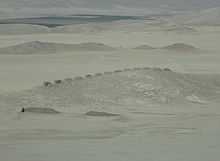Chankillo
| Chankillo | |
|---|---|
 | |
| Alternate name | Chanquillo |
| Location | Ancash Region, Peru |
| Coordinates | 09°33′24″S 78°14′09″W / 9.55667°S 78.23583°WCoordinates: 09°33′24″S 78°14′09″W / 9.55667°S 78.23583°W |
| Type | Fortified sanctuary |
| Area | 4 km2 (1.5 sq mi) |
| History | |
| Founded | 300 BC |
Chankillo is an ancient monumental complex in the Peruvian coastal desert, found in the Casma-Sechin Oasis in the Ancash Department of Peru. The ruins include the hilltop Chankillo fort, the nearby Thirteen Towers solar observatory, and residential and gathering areas. The Thirteen Towers have been interpreted as an astronomical observatory built in the 4th century BC.[1][2] As of 2008, the culture that produced Chankillo is unnamed.[3]
The site covers about four square kilometres (1.5 square miles) and has been interpreted as a fortified temple.[4]
The Thirteen Towers solar observatory

The regularly-spaced thirteen towers of Chankillo were constructed atop the ridge of a low hill running near north to south and are, forming a "toothed" horizon with narrow gaps at regular intervals. To the east and west investigators designated two possible observation points. From these vantages, the 300m long spread of the towers along the horizon corresponds very closely to the rising and setting positions of the Sun over the year,[1][2] albeit they are not all visible. On the winter solstice, the sun would rise behind the leftmost tower of Chankillo and rise behind each of the towers until it reached the rightmost tower six months later on the summer solstice, marking the passage of time.[5] The Thirteen Towers of Chankillo could be the earliest known observatory in the Americas. Inhabitants of Chankillo would have been able to determine an accurate date, with an error of a day or two, by observing the sunrise or sunset from the correct tower.[6]
The towers had been known to travelers for centuries, but the astronomical function of the towers was first hypothesized in 2007 by Iván Ghezzi and Clive Ruggles.[7]
.jpg)
See also
Notes
- ↑ 1.0 1.1 Ghezzi and Ruggles (2007).
- ↑ 2.0 2.1 BBC/Open University documentary, Broadcast March 2011, Downloadable demonstration of Towers at sunrise.
- ↑ Atwood
- ↑ Ghezzi (2006)
- ↑ http://hila.webcentre.ca/projects/chankillo/
- ↑ http://www.wmf.org/project/chankillo
- ↑ Atwood, Roger. " "Solar Observatory at Chankillo, Peru." Archaeology. Volume 61 Number 1, January/February 2008. http://www.archaeology.org/0801/topten/solar_observatory.html.
References
- Ghezzi, Ivan (2006). "Religious Warfare at Chankillo". In William Harris Isbell and Helaine Silverman (eds.). Andean Archaeology III: North and South. New York: Springer. pp. 67–84. doi:10.1007/0-387-28940-2. ISBN 978-0-387-28939-7. OCLC 71272735.
- Ghezzi, Ivan; and Clive Ruggles (2 March 2007). "Chankillo: A 2300-Year-Old Solar Observatory in Coastal Peru". Science (Washington, DC: AAAS) 315 (5816): pp. 1239–1243. doi:10.1126/science.1136415. ISSN 0036-8075. OCLC 110607624. PMID 17332405.
External links
- Chankillo, Peru, Ancient Solar Observatory?
- Towers point to ancient Sun cult, BBC
- Giant Solar Calendar Measures Time, BBC
- Early Monumental Architecture on the Peruvian Coast
- Yale University article: Peruvian Citadel is Site of Earliest Ancient Solar Observatory in the Americas and slide show
- View from the air on the Chankillo site
- Wonders of the Universe, Prof. Brian Cox, BBC (maybe region locked to UK only)
